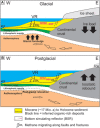A 160,000-year-old history of tectonically controlled methane seepage in the Arctic
- PMID: 31457082
- PMCID: PMC6685712
- DOI: 10.1126/sciadv.aaw1450
A 160,000-year-old history of tectonically controlled methane seepage in the Arctic
Abstract
The geological factors controlling gas release from Arctic deep-water gas reservoirs through seabed methane seeps are poorly constrained. This is partly due to limited data on the precise chronology of past methane emission episodes. Here, we use uranium-thorium dating of seep carbonates sampled from the seabed and from cores drilled at the Vestnesa Ridge, off West Svalbard (79°N, ~1200 m water depth). The carbonate ages reveal three emission episodes during the Penultimate Glacial Maximum (~160,000 to 133,000 years ago), during an interstadial in the last glacial (~50,000 to 40,000 years ago), and in the aftermath of the Last Glacial Maximum (~20,000 to 5,000 years ago), respectively. This chronology suggests that glacial tectonics induced by ice sheet fluctuations on Svalbard mainly controlled methane release from Vestnesa Ridge. Data corroborate past methane release in response to Northern Hemisphere cryosphere variations and suggest that Arctic deep-water gas reservoirs are sensitive to temperature variations over Quaternary time scales.
Figures




References
-
- Gauthier D. L., Bird K. J., Charpentier R. R., Grantz A., Houseknecht D. W., Klett T. R., Moore T. E., Pitman J. K., Schenk C. J., Schuenemeyer J. H., Sørensen K., Tennyson M. E., Valin Z. C., Wandrey C. J., Assessment of undiscovered oil and gas in the Arctic. Science 324, 1175–1179 (2009). - PubMed
-
- Stewart I. S., Sauber J., Rose J., Glacio-seismotectonics: Ice sheets, crustal deformation and seismicity. Quat. Sci. Rev. 19, 1367–1389 (2000).
-
- Patton H., Hubbard A., Andreassen K., Auriac A., Whitehouse P. L., Stroeven A. P., Shackleton C., Winsborrow M., Heyman J., Hall A. M., Deglaciation of the Eurasian ice sheet complex. Quat. Sci. Rev. 169, 148–172 (2017).
-
- Ruppel C. D., Kessler J. D., The interaction of climate change and methane hydrates. Rev. Geophys. 55, 126–168 (2017).
-
- Plaza-Faverola A., Bünz S., Johnson J. E., Chand S., Knies J., Mienert J., Franek P., Role of tectonic stress in seepage evolution along the gas hydrate-charged Vestnesa Ridge, Fram Strait. Geophys. Res. Lett. 42, 733–742 (2015).
LinkOut - more resources
Full Text Sources
Miscellaneous

